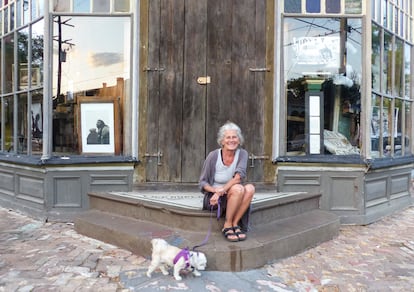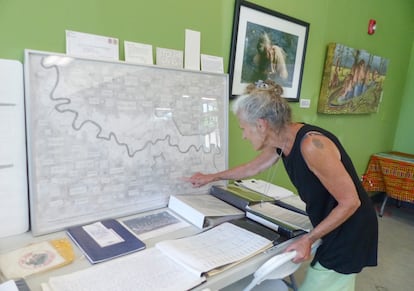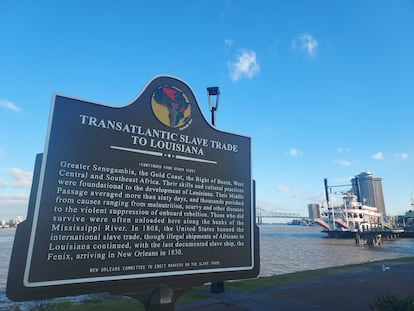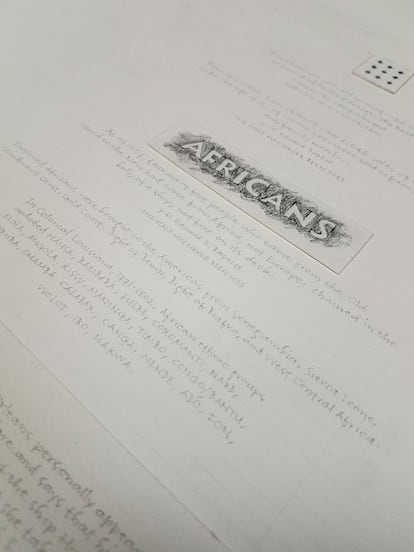60,000 names of forgotten slaves rescued in pencil
American calligrapher and researcher Phyllis Goodnow has collected a list of thousands of victims of the slave trade in a project to honor their history


“FANNY, 22 years old. And her son DAVID, 3 years old, and her daughter, 5 months old. Sold to Eugénie Dupré for $900.” Written in 3H graphite pencil on an extensive white sheet, Fanny without a surname and with the sonority of an affectionate abbreviation of an English name, was one of the African-Americans enslaved in the United States from 1808 to 1860. We now know that she and her minimal history existed because of the zeal of 75-year-old calligrapher and researcher Phyllis Goodnow to give visibility to 60,000 slaves who were bought, stolen, sold, and sent to the south of the U.S. during that period through her project History Enslaved / History in Bondage. It has taken her eight years to compile and trace every letter of the onomastic list of each of the individuals recorded on 30 rolls of microfilm she found while researching at the National Archives in Washington D. C., titled “Slave Manifests of Coastwise Vessels Filed at New Orleans, Louisiana, 1807-1860.”
“They lost their history and deserve recognition. They worked terribly, and they died,” Goodnow says about her work, on display at the Katrina National Memorial Foundation Museum in New Orleans. “I don’t feel guilty about what happened, but I feel horrible. We’re all human beings,” says the wiry, green-eyed Goodnow, who has altruistically given her project to the foundation to extend the purpose of an overwhelming body of work.

There are 40 sheets of 22x30″ (50x76 centimeters) with a string of names and ages of people who, against their will, fundamentally raised the cotton and sugar industry in New Orleans, and of girls who swatted away the flies from their masters with a fan for hours on end, until their arms were burning.
Henry, Armistead, Lucy, Abraham, Lloyd, Mary… in the stroke of each name one witnesses thousands of overlooked lives emerging in the color of graphite. “It’s incredible. There are cases in which children were separated from their mothers to be sold separately. Or where the baby born to a pregnant slave woman was already considered a slave,” says Goodnow, who explains that after every eight or nine names she wrote she would sharpen the pencil, so that they would all look well-defined. “It has been a very slow and sad process. But I’ve also learned from the history of slavery in this country.”
Goodnow feels that her contribution is minimal, and that 60,000 “is a relatively ‘small’ number compared to the approximately 4 millions of enslaved humans in the Deep South at the outset of the Civil War (1861-1865).” In total there were many, many more, comprising numerous generations since the first infamous slave ships from Africa began to dock on American shores. Between 1525 and 1866, some 12.5 million Africans were uprooted from their homelands and taken to the so-called New World. Of these, 10.7 million survived the voyage and landed in North America, the Caribbean and Latin America, according to estimates reflected in the Trans-Atlantic Slave Trade database available from the Slaves Voyages scholarly project. Of these, says Professor Henry Louis Gates, a leading expert in the field, citing the database, 388,000 were transported directly to North America, or as many as 450,000 if you add those landed in the Caribbean but moved up north. “Incredibly, most of the 42 million members of the African-American community descend from this tiny group of less than half a million Africans,” he notes in an article in The Root.

On the banks of the Mississippi River across from Jackson Square in New Orleans, a plaque bears witness to the origin of these slaves, transported by the transatlantic trade to the state of Louisiana, listing the names of many of those who arrived from “Greater Senegambia, the Gold Coast, the Bight of Benin, West Central and Southeast Africa. Their skills and cultural practices were foundational to the development of Louisiana.” All of these people had their names taken away. “Once brought to the colony and sold, slaves were usually given Christian or classical names, from Greco-Roman civilization,” writes Senegalese historian Ibrahima Seck, academic director of the Whitney Plantation in New Orleans, in his book Bouki Fait Gombo: A History of the Slave Community. “Some names were inspired by popular works of the time. Lindor, probably the most common male name in the Louisiana Slave Database, is a character from The Barber of Seville,” he notes.

In his book, Seck also compiles the onomastics belonging to many of the people mentioned on the Jackson Square plaque. “In Senegambia, children are still named after some days of the week [...] The most popular is Aljuma [Friday], the day when the faithful gather en masse in Muslim countries,” the researcher explains. Goodnow says that she found some Muslim names among the lists, and other denigrating ones such as Sambo, designed to humiliate. The artist, who has a degree in Fine Arts, believed that in order to finish honoring her protagonists, she also had to make some accompanying panels putting the period into context. She thus drew the plantations that spread out in rectangles on both sides of the banks of the Mississippi River, and recreated the French Quarter of the city of New Orleans with data on slave auction houses, the names of traffickers and other figures involved in the practice, which was abolished in 1865. She now considers her work completed. “This work is no longer mine; it now belongs to everyone,” says Goodnow, relieved in the hope of having rescued the dignity of 60,000 people in pencil.

Sign up for our weekly newsletter to get more English-language news coverage from EL PAÍS USA Edition
Tu suscripción se está usando en otro dispositivo
¿Quieres añadir otro usuario a tu suscripción?
Si continúas leyendo en este dispositivo, no se podrá leer en el otro.
FlechaTu suscripción se está usando en otro dispositivo y solo puedes acceder a EL PAÍS desde un dispositivo a la vez.
Si quieres compartir tu cuenta, cambia tu suscripción a la modalidad Premium, así podrás añadir otro usuario. Cada uno accederá con su propia cuenta de email, lo que os permitirá personalizar vuestra experiencia en EL PAÍS.
¿Tienes una suscripción de empresa? Accede aquí para contratar más cuentas.
En el caso de no saber quién está usando tu cuenta, te recomendamos cambiar tu contraseña aquí.
Si decides continuar compartiendo tu cuenta, este mensaje se mostrará en tu dispositivo y en el de la otra persona que está usando tu cuenta de forma indefinida, afectando a tu experiencia de lectura. Puedes consultar aquí los términos y condiciones de la suscripción digital.
Archived In
Últimas noticias
Most viewed
- Oona Chaplin: ‘I told James Cameron that I was living in a treehouse and starting a permaculture project with a friend’
- Reinhard Genzel, Nobel laureate in physics: ‘One-minute videos will never give you the truth’
- Sinaloa Cartel war is taking its toll on Los Chapitos
- Why the price of coffee has skyrocketed: from Brazilian plantations to specialty coffee houses
- Chevy Chase, the beloved comedian who was a monster off camera: ‘Not everyone hated him, just the people who’ve worked with him’








































